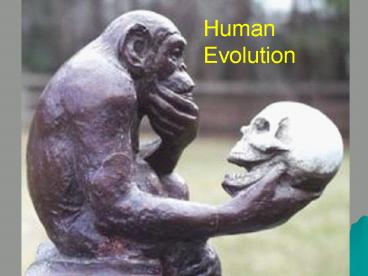Human Evolution - PowerPoint PPT Presentation
1 / 43
Title:
Human Evolution
Description:
Darwin proposed that humans, gorillas, and chimpanzees descended from common ancestor ... chimpanzees, orangutans, gorillas & humans. gibbon. orangutan ... – PowerPoint PPT presentation
Number of Views:5273
Avg rating:3.0/5.0
Title: Human Evolution
1
Human Evolution
2
The Descent of Man
- Published 1871, 12 years after The Origin of
Species - Darwin proposed that humans, gorillas, and
chimpanzees descended from common ancestor
3
Evolution of primates
hominoids
Primate ancestor
The two main groups of primates are prosimians
and anthropoids
4
Primate ancestor
- The first primate evolved 50-60 mya
5
Characteristics of primates
Many adaptations are useful for living in trees
- Binocular vision
- Due to forward placement of eyes
- Grasping hands and feet
- Well-developed cerebrum
- Arms that can rotate around the shoulders
6
Binocular vision
- Eyes face forward, giving overlapping fields of
view - Provides 3-D view
- Depth perception needed for movement in trees,
seizing food
Mouse lemur
7
Grasping hands and feet
- Grasping fingers that curl around objects
- Only primates have both binocular vision and
grasping hands
Arms that rotate around the shoulder
- Adaptation to climbing
8
Well-developed cerebrum
- Thinking area of the brain
9
Prosimians
- Small, nocturnal
- Large eyes adapted for seeing in the dark
- Branched off very early from common ancestor
- Present day prosimians
- lemurs, bush babies, lorises, tarsiers
10
- Lemur
- Madagascar
11
- Loris
- India
12
- Bush baby
- Africa
13
- Tarsier
- Borneo
14
Anthropoids
- Humanlike primates
- Two branches
- New World monkeys
- Live in trees
- Prehensile tail
- Old World monkeys and great apes
- Old World Monkeys (baboons and macaques)
- Live in trees
- No prehensile tail
- Great apes or hominoids
- (gibbons, orangutans, chimpanzees, humans)
15
Black-handed Spider Monkey --- A New World monkey
16
Old World Monkeys
macaques
baboon
17
(No Transcript)
18
Great apes or hominoids
- Gibbons, chimpanzees, orangutans, gorillas
humans
gibbon
orangutan
19
Gorilla gorilla Second closest relative to humans
20
Bonobo or pygmy chimpanzee Pan paniscus
Democratic Republic of Congo
Common chimpanzee Pan troglodytes Equatorial
Africa
21
Chimpanzees
- Closest relative to humans
- 98 DNA is same
22
Hominids
- Primates that can walk upright on two legs
bipedal - Frees both hands for using tools
- Opposable thumb
- Large brain
- (human brain 1200 1600 cm3)
23
Early Human Ancestors
24
Genus Australopithecus
- Earliest known ancestors
- Some species direct ancestors some separate
branches - 4 mya to 1 mya
See family tree on pg. 839
25
Australopithecus africanus
- Discovered by Raymond Dart, 1924
- Claimed to be the long-sought evolutionary link
between humans and apes
26
Australopithecus afarensis
- Discovered by Donald Johanson in Ethiopia, 1974
Lucy lived 3.2 million years ago.
27
Paranthropus and Kenyanthropus
- Scientists unable to agree on how to place these
on family - Up to 4 hominid species coexisted at the same time
28
Kenyanthropus
- First discovered by Maeve Leakey in 2001
- Kenyanthropus platyops
- - Combines features of both
- chimpanzees and genus Homo
29
Kenyanthropus platyops
30
Modern humans Genus Homo
- Appeared 2.5 mya in Africa
- Homo habilis Handy Man
- Fossils found with tools
- Earliest fossil, lived 2.5 mya in Africa
- Homo erectus (Java man)
- Migrated from Africa to Asia
31
Homo habilis
32
Homo erectus
33
Two theories for Homo sapiens origin
- Multi-regional model
- Homo sapiens descended from Homo erectus already
living outside Africa - Out-of-Africa model
- Homo sapiens evolved in Africa, then migrated to
other continents - This theory supported by mitochondrial DNA data /
most widely accepted
34
The past 500,000 years
- Homo neanderthalensis, Neanderthal man
- Flourished 200,000-30,000 ya
- Europe, middle East, western Asia
- Short, powerfully built massive skull,
protruding face, heavy ridge over brow - Took care of sick, buried their dead may have
believed in life after death abstract thinking - Abruptly disappeared 34,000 ya
35
Homo neanderthalensis
36
The past 500,000 years
- Homo sapiens (wise man)
- Homo sapiens lived at the same time as
Neanderthals in mid-East - Evidence of changes 50-40000 ya sophistication
of tools, art, rituals---similar to modern humans
37
(No Transcript)
38
Early modern humans
- Lived by hunting
- Complex patterns of social interaction
- Sophisticated language
- Crossed land bridge from Siberia to North America
39
Homo sapiens today
- Effective use of tools
- Symbolic language
- Cultural evolution
- Change environment rather than changing ourselves
in response to the environment
40
Comparison of Skulls of Human Ancestors
Large brow ridge
Large nose
Large canine teeth
Face protrudes forward
Australopithecus afarensis
Homo erectus
Round, high skull
Weak brow ridge
Large brain case
Inflated cheeks
Largenose
Even teeth
Strong chin
Neanderthal
Cro-Magnon
Modern Homo sapiens
41
(No Transcript)
42
Human and Gorilla Skeletons
Section 32-3
Modern Human
Comparing Human and Gorilla Skeletons
Modern Human
Modern Gorilla
Modern Gorilla
Skull atopS-shaped spine Spinal cord exitsat
bottom of skull Arms shorter thanlegs hands do
not touch groundduring walking Pelvis is
bowl-shaped Thigh bones angledinward,
directlybelow body
Skull atopC-shaped spine Spinal cord exitsnear
back of skull Arms longer thanlegs hands touch
ground during walking Pelvis is longand
narrow Thigh bones angledaway from pelvis
43
(No Transcript)































